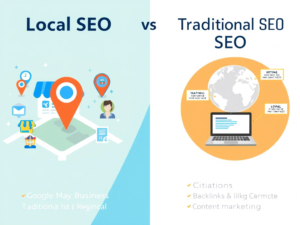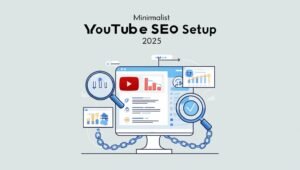In today’s digital world, Local vs Traditional SEO in 2025 determines how businesses rank online. While every brand aims for Google’s first page, strategies vary: a local bakery needs to attract nearby customers, while an online store targets national or global audiences. This is where the power of localized optimization meets broad-scale SEO .
In this guide by Themesyde, we’ll break down both approaches, compare their strengths, and share real-world examples to help you pick the best SEO strategy for your business goals in 2025 and beyond
Table of Contents
📍 Local SEO: Dominate Your Neighborhood
(Also called: Hyperlocal SEO)
What is it?
Local SEO helps physical businesses appear in searches like “coffee shop near me” or “plumber in Los Angeles.” It’s all about proximity and relevance .
How It Works (Deep Dive):
1.Google Business Profile (GBP):
- Add photos, services, and business hours .
- Post weekly updates (e.g., “20% off this weekend!”).
- Reply to all reviews (even negative ones) to show you care.

2.Local Keyword Magic:
- Use geo-modifiers like “cheap landscaping service in Miami” or “emergency dentist open now.”
- Optimize for “near me” searches (e.g., “best pizza delivery near me”).
Citations & NAP Consistency:
- List your business on Yelp, YellowPages, and Bing Places with the exact same name, address, and phone number (NAP) .
- Fix inconsistent listings (e.g., “123 Main St” vs. “123 Main Street”).
Map Pack Domination:
- Aim for the “Local 3-Pack” (top 3 Google Maps results).
- Use localized landing pages (e.g., “/services/denver” for a Denver-based HVAC company).
📱 Mobile-First Edge:
- 60% of local searches happen on mobile (Google).
- Ensure your site loads in under 3 seconds and has click-to-call buttons .
🚀 Best for:
- Brick-and-mortar stores (e.g., grocery stores, salons).
- Service-area businesses (e.g., electricians, locksmiths).
- Restaurants/cafés relying on foot traffic.
📊 Why It Matters:
- “72% of consumers who search for a local business visit a store within 5 miles” (Google).
- Reviews directly impact rankings: A 4.5+ rating boosts map pack chances by 70%.
🌐 Traditional SEO: Scale Your Reach Nationwide (or Globally)
(Also called: National/Global SEO)
What is it?
Traditional SEO focuses on ranking your website for broad, non-location-specific keywords to attract audiences nationwide or globally. It’s ideal for businesses that don’t rely on physical foot traffic.

How It Works (Deep Dive):
Keyword Strategy:
- Target high-volume, competitive keywords like “best project management tools” or “how to start a blog.”
- Use tools like Ahrefs or Semrush to find keywords with high search intent and low competition.
Content is King:
- Create pillar pages (e.g., “Ultimate Guide to Digital Marketing”) and cluster content (e.g., “How to Use Instagram Ads”) to dominate topics.
- Use FAQ sections to answer common user queries (e.g., “What is cloud computing?”).
Technical Mastery:
- Fix 404 errors and create a sitemap.xml for Google to crawl your site efficiently.
- Use schema markup to help Google understand your content (e.g., product reviews, recipes).
Authority Building:
- Earn backlinks from high-DA websites (e.g., guest posting on Forbes or industry blogs).
- Publish original research or case studies to attract organic links.
🚀 Best for:
- E-commerce stores selling products nationwide (e.g., Amazon, Shopify stores).
- SaaS companies targeting global users (e.g., Canva, Zoom).
- Blogs/affiliates monetizing traffic (e.g., finance, tech blogs).
📊 Why It Matters:
- “Websites ranking #1 on Google get 39.6% of all clicks” (Backlinko).
- Long-term results: A single blog post can drive traffic for years with proper optimization.
⚖️ Key Differences Between Local SEO & Traditional SEO
| Factor | Local SEO | Traditional SEO |
|---|
| 🎯 Target Audience | Nearby/local customers | National or global visitors |
| 📍 Search Type | “Near me” or city-based keywords | Topic-based or industry keywords |
| 📍 Listings | Google Business Profile, Local directories | Not required |
| 🗺️ Google Maps Visibility | Critical (Map Pack) | Not important |
| 📝 Content Focus | Location-specific pages (“Plumber in Miami”) | Informational blogs & guides |
| ⭐ Customer Reviews | Highly impact rankings | Optional (for trust) |
| 🔗 Backlinks | Fewer, but local links work | High-authority national backlinks matter |
| 📱 Mobile Optimization | Must-have due to 60% mobile local searches | Important, but not always critical |
💡 Real-World Example 1: A Dentist Clinic
🔹 Traditional SEO Approach:
Dr. Lee’s Dental Care in Los Angeles creates blog posts like:
- “Best Teeth Whitening Methods”
- “How Often Should You Visit the Dentist?”
These rank on a national level, attract readers from everywhere, and build long-term traffic — even if many readers aren’t in L.A.
🔹 Local SEO Approach:
But to get actual patients in Los Angeles, Dr. Lee focuses on:
- A fully optimized Google Business Profile
- Keywords like: “Dentist in Los Angeles” or “emergency dental care near me”
- Getting 5-star reviews from happy clients
- Adding local schema like: business hours, maps, and services
📍 Result: Dr. Lee appears in Google’s Local 3-Pack — top 3 map results — and gets calls directly from mobile searches.
💡 Real-World Example 2: A Restaurant Business
🔹 Traditional SEO Approach:
TasteHub Restaurant runs a national-level blog for food lovers.
They create articles like:
- “Top 10 Pasta Recipes from Italy”
- “Healthy Eating Habits You Should Try”
These posts attract traffic from the USA, UK, Canada—even if none of those visitors ever come to the restaurant. This builds brand visibility but doesn’t directly bring in foot traffic.
🔹 Local SEO Approach:
But to attract actual diners, TasteHub focuses on:
✅ Local Keywords:
“Best Italian restaurant in Brooklyn”
“Family dinner near me”
“Vegan pizza in Brooklyn NY”
✅ Google Business Profile Optimization:
- Add photos of the restaurant, dishes, ambiance
- Ensure NAP (Name, Address, Phone) consistency across Yelp, TripAdvisor, and Apple Maps
- Enable “Reserve a Table” feature with links
✅ 5-Star Reviews Strategy:
After every meal, staff politely asks:
“Would you mind leaving us a quick Google review if you enjoyed your meal?”
✅ Mobile-First Website:
- Fast loading menu
- Click-to-call button
- Google Maps embed
Because hungry users search from phones, 60%+ of local food searches happen on mobile.
📊 Comparison Table: Local SEO vs Traditional SEO
| Factor | Local SEO | Traditional SEO |
|---|---|---|
| Target Audience | Nearby/local customers who need immediate service | Nationwide/global customers looking for information or services |
| Keyword Type | City-based, “near me” searches (e.g., “Plumber in Chicago”) | Industry-based, general terms (e.g., “best plumbing services”) |
| Google Presence | Google Maps, local 3-pack, business listings | Organic results, blogs, guides, national directories |
| Backlinks | Local directories, local business partnerships | High-authority websites, national publications |
| Customer Interaction | Encourages reviews, ratings, and local engagement | Generally focuses on trust-building content |
| Mobile-Friendliness | Essential, since 60% of local searches happen on mobile | Still important, but not as critical |
| Example Keywords | “Best dentist in New York”, “pizza near me” | “How to improve SEO for your website” |
| Tools | Google My Business, Yelp, Apple Maps | Google Search Console, Ahrefs, SEMrush |
| Conversion Focus | Driving foot traffic, calls, walk-ins | Building long-term website traffic and brand awareness |
👗 Real-World Example 3: Online Clothing Store
🔹 Traditional SEO Approach:
TrendyWear Online Store runs a blog covering topics like:
- “Fashion Trends for Fall 2025”
- “How to Style Your Wardrobe for Work and Play”
These blog posts help build brand recognition, but don’t bring in immediate buyers. People may read the articles, but they may not be ready to make a purchase right away, especially if they don’t have a store nearby.
🔹 Local SEO Approach:
But when TrendyWear focuses on local SEO, they get more immediate conversions because they target customers looking for nearby stores:
✅ Local Keywords:
“Best boutique in Chicago”
“Summer dresses in Miami”
“Trendy outfits near me”
✅ Google Business Profile Optimization:
- Showcase photos of the store with people wearing TrendyWear’s outfits
- Add directions, hours, and location for people searching for the store nearby
✅ Mobile-Friendliness:
Because customers searching for clothes may search while shopping or on-the-go, TrendyWear ensures that the website is fast, mobile-responsive, and includes the “Find a Store” feature.
🚀 Why Local SEO + Traditional SEO = Unstoppable Growth
(Think of it like a sprint + marathon combo!)
While Local SEO and Traditional SEO have different goals, combining them is like using a rocket booster (Local SEO) to fuel your long-term mission (Traditional SEO) . Here’s how to make them work together:

1. Local SEO = Your Launchpad for National Dominance
(Start small, dream big!)
How it works:
- Build credibility locally first. A strong local presence (reviews, Google Business Profile, local content) makes your brand trustworthy.
- Use local success as social proof. Highlight awards like “Best Coffee Shop in Austin” in your national campaigns.
Example:
A boutique in Miami starts by ranking for “unique gifts in Miami” and collects 100+ 5-star reviews. Later, they expand with blogs like “Top 10 Unique Gifts for 2025” to target national shoppers.
📊 Stat Alert:
Businesses with 4.5+ Google reviews are 70% more likely to rank nationally (BrightLocal).
2. Local SEO Gives Instant Results. Traditional SEO Builds Legacy.
(Like getting cash now vs. investing in stocks!)
- Local SEO = Quick cash:
Appear in Google’s Local 3-Pack today and attract customers searching “plumber near me.” - Traditional SEO = Long-term wealth:
Create evergreen content (e.g., “How to Fix a Leaky Faucet” ) that ranks for years.
Pro Tip:
Use Local SEO to test keywords before scaling nationally. If “best pizza in Chicago” works, expand to “best deep-dish pizza recipes” for a broader audience.
3. Double Your Visibility with “Location + Content” Magic
(Turn your local charm into global appeal!)
How to combine both:
- Step 1: Write a blog post titled “10 Must-Try Breakfast Spots in Nashville” (Local SEO).
- Step 2: Repurpose it into “10 Breakfast Recipes Inspired by Nashville” (Traditional SEO).
- Step 3: Use schema markup to tell Google your Nashville location.
🔑 Hybrid Strategy:
- For Local: Optimize for “emergency electrician in Denver” + Google Posts about same-day service.
- For Traditional: Publish “Ultimate Home Maintenance Checklist” to rank nationally.
🌟 Why This Combo Works (Real Talk):
- Local SEO gets you found by neighbors → builds trust.
- Traditional SEO gets you found by the world → builds authority.
- Together: You’re seen as a local hero with global expertise .
Final Thought:
Imagine a customer in Texas finding your Dallas-based HVAC company via Local SEO, then sharing your “Energy-Saving Tips” blog (Traditional SEO) with friends in California. That’s how you turn local wins into national growth.
✅ Action Steps to Start Today:
- Claim your Google Business Profile (if not done already).
- Write one local blog post + one broad-topic post this month.
- Use AnswerThePublic to find location-specific questions your audience is asking.
Need a tool? Try Moz Local for GBP management + Ahrefs for keyword research.
Let me know if you want to refine this further! 😊
🎯 Conclusion: Choose the Right SEO Strategy for 2025 & Beyond
In 2025, Local SEO and Traditional SEO aren’t rivals—they’re partners in your business growth.
- Pick Local SEO if you’re a neighborhood café, clinic, or contractor wanting immediate foot traffic .
- Choose Traditional SEO if you’re a SaaS company, blogger, or e-commerce brand aiming for national/global dominance .
- Combine Both to dominate locally and scale globally (e.g., a restaurant chain using Local SEO for walk-ins and Traditional SEO for its meal-kit delivery service).
The key? Start where your customers are. If they’re searching “near me” today, prioritize Local SEO. If they’re hunting for “best tools for remote work” tomorrow, invest in Traditional SEO.
🚀 Ready to Grow?
Audit your current strategy: Are you missing local traffic? Or leaving global opportunities on the table? Let Themesyde help you bridge the gap.
What’s the #1 difference between Local and Traditional SEO?

Local SEO targets location-specific searches (e.g., “best pizza in Chicago” ), while Traditional SEO focuses on broad, national/global keywords (e.g., “how to make pizza at home” ).
Which is better for a small business?
Local SEO wins for small businesses serving a community (e.g., salons, plumbers). It’s faster, cheaper, and drives real-world customers .
Can I use both strategies together?
Absolutely! For example:
Use Local SEO to rank in Google Maps.
Use Traditional SEO to create evergreen content (e.g., “Home Maintenance Tips” ).
This combo builds trust locally and authority globally
What tools do I need for Local SEO?
Google Business Profile (free, essential).
BrightLocal or Moz Local for tracking rankings.
ReviewTrackers to manage customer feedback.
How long does Local SEO take to work?
Most businesses see results in 3–6 months with consistent effort (e.g., weekly GBP posts, review collection).
Do online reviews really impact SEO?
Yes! 72% of consumers trust businesses with 4.5+ Google reviews (Source: Search Engine Land). Encourage happy customers to leave feedback.
How do I track my SEO success?
Use:
Google Analytics for traffic trends.
Google Search Console for keyword rankings.
SEMrush or Ahrefs for competitor analysis.





12 Responses
I’m often to blogging and i really appreciate your content. The article has actually peaks my interest. I’m going to bookmark your web site and maintain checking for brand spanking new information.
Really appreciate your kind feedback! Great to hear it sparked your interest. More exciting content is on the way — stay tuned!
I like the efforts you have put in this, regards for all the great content.
thanks
naturally like your web site however you need to take a look at the spelling on several of your posts. A number of them are rife with spelling problems and I find it very bothersome to tell the truth on the other hand I will surely come again again.
Thank you for visiting my post. Next time, I’ll write something unique again to add to your knowledge. Once again, thank you!
Your article helped me a lot, is there any more related content? Thanks!
I’m really glad it helped you! Yes, I’ll be sharing more related content soon. Stay connected!
I am truly thankful to the owner of this web site who has shared this fantastic piece of writing at at this place.
Thank you so much for your kind words! I’m really happy you found it valuable. Your support truly means a lot!
I truly appreciate your technique of writing a blog. I added it to my bookmark site list and will
Thank you so much! I’m really glad you found it valuable. It means a lot that you bookmarked it — more useful content coming soon!